Management and Operations in HSBC Bank: An Analysis of Leadership and Management Concepts
VerifiedAdded on 2023/06/18
|16
|4809
|399
AI Summary
This article analyzes the roles and responsibilities of managers and leaders in HSBC Bank, highlighting the differences between management and leadership. It also evaluates different approaches to leadership and management and their impact on the organization, and provides recommendations for future improvements. The article covers key operational functions, approaches to operations management, and external business environment factors affecting decision-making by leaders and managers. It provides insights on how operational efficiencies can be improved to successfully meet business objectives using appropriate management and leadership approaches. The subject is Management and Operations in HSBC Bank, and the course code and college/university are not mentioned.
Contribute Materials
Your contribution can guide someone’s learning journey. Share your
documents today.
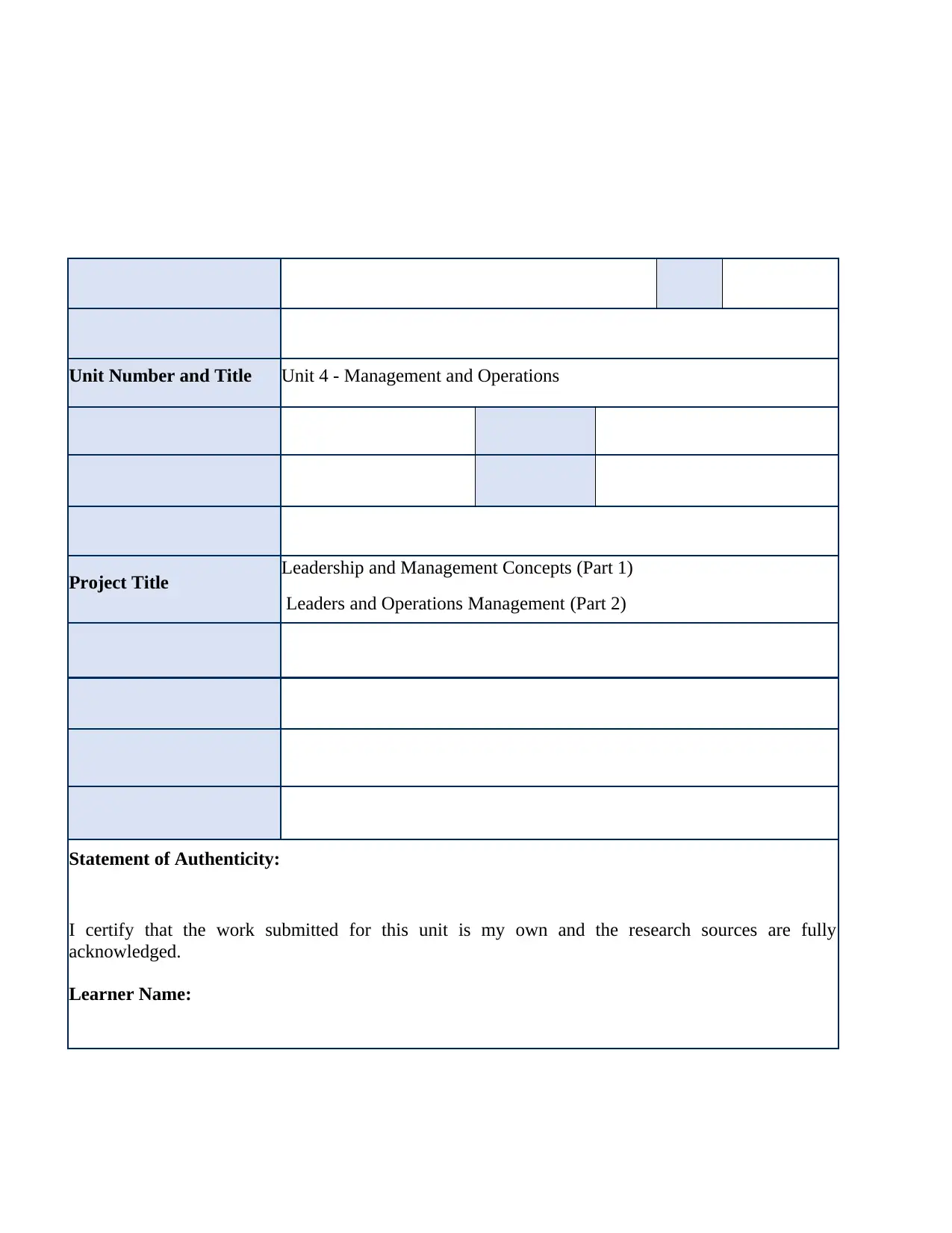
Unit Number and Title Unit 4 - Management and Operations
Project Title Leadership and Management Concepts (Part 1)
Leaders and Operations Management (Part 2)
Statement of Authenticity:
I certify that the work submitted for this unit is my own and the research sources are fully
acknowledged.
Learner Name:
Project Title Leadership and Management Concepts (Part 1)
Leaders and Operations Management (Part 2)
Statement of Authenticity:
I certify that the work submitted for this unit is my own and the research sources are fully
acknowledged.
Learner Name:
Secure Best Marks with AI Grader
Need help grading? Try our AI Grader for instant feedback on your assignments.
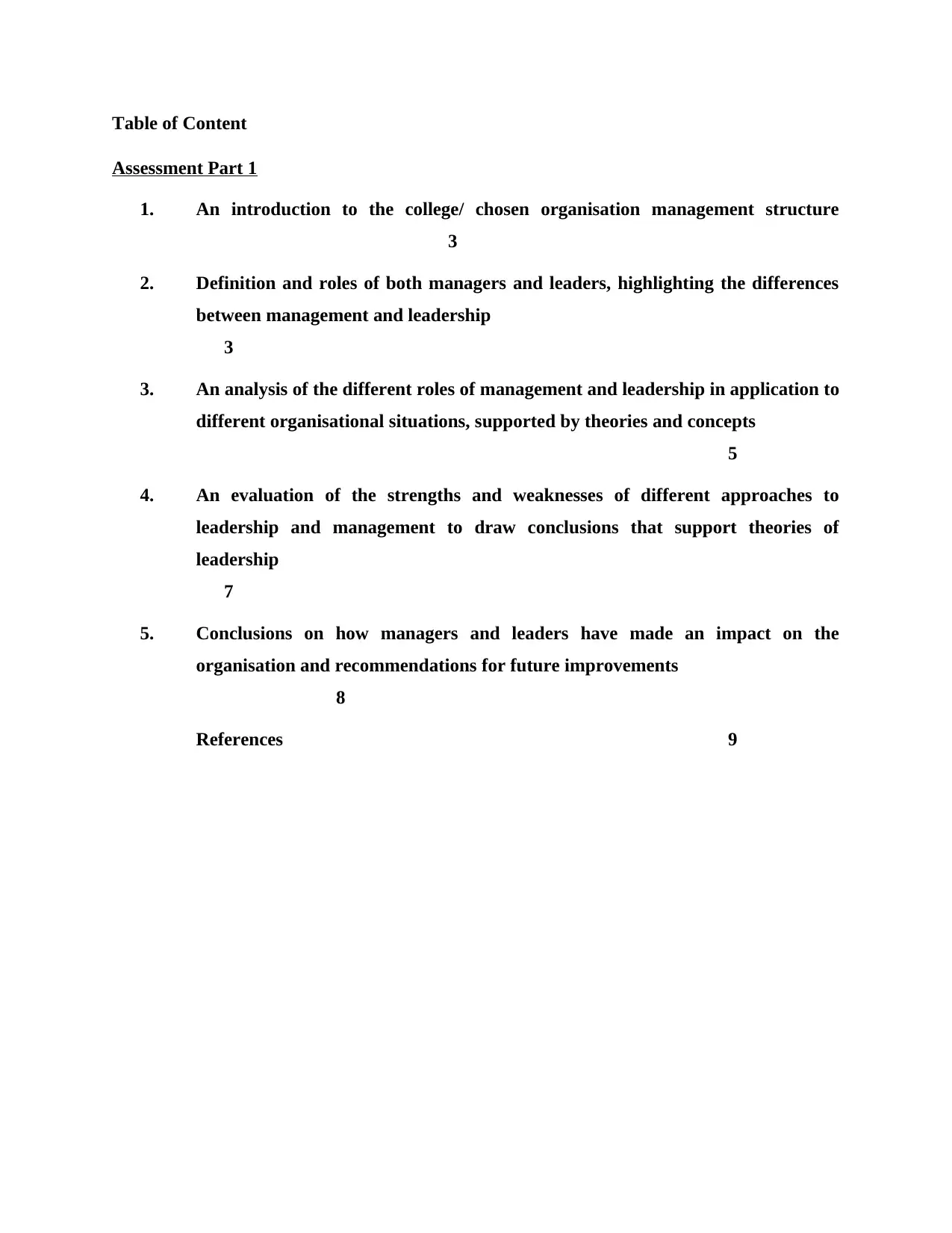
Table of Content
Assessment Part 1
1. An introduction to the college/ chosen organisation management structure
3
2. Definition and roles of both managers and leaders, highlighting the differences
between management and leadership
3
3. An analysis of the different roles of management and leadership in application to
different organisational situations, supported by theories and concepts
5
4. An evaluation of the strengths and weaknesses of different approaches to
leadership and management to draw conclusions that support theories of
leadership
7
5. Conclusions on how managers and leaders have made an impact on the
organisation and recommendations for future improvements
8
References 9
Assessment Part 1
1. An introduction to the college/ chosen organisation management structure
3
2. Definition and roles of both managers and leaders, highlighting the differences
between management and leadership
3
3. An analysis of the different roles of management and leadership in application to
different organisational situations, supported by theories and concepts
5
4. An evaluation of the strengths and weaknesses of different approaches to
leadership and management to draw conclusions that support theories of
leadership
7
5. Conclusions on how managers and leaders have made an impact on the
organisation and recommendations for future improvements
8
References 9
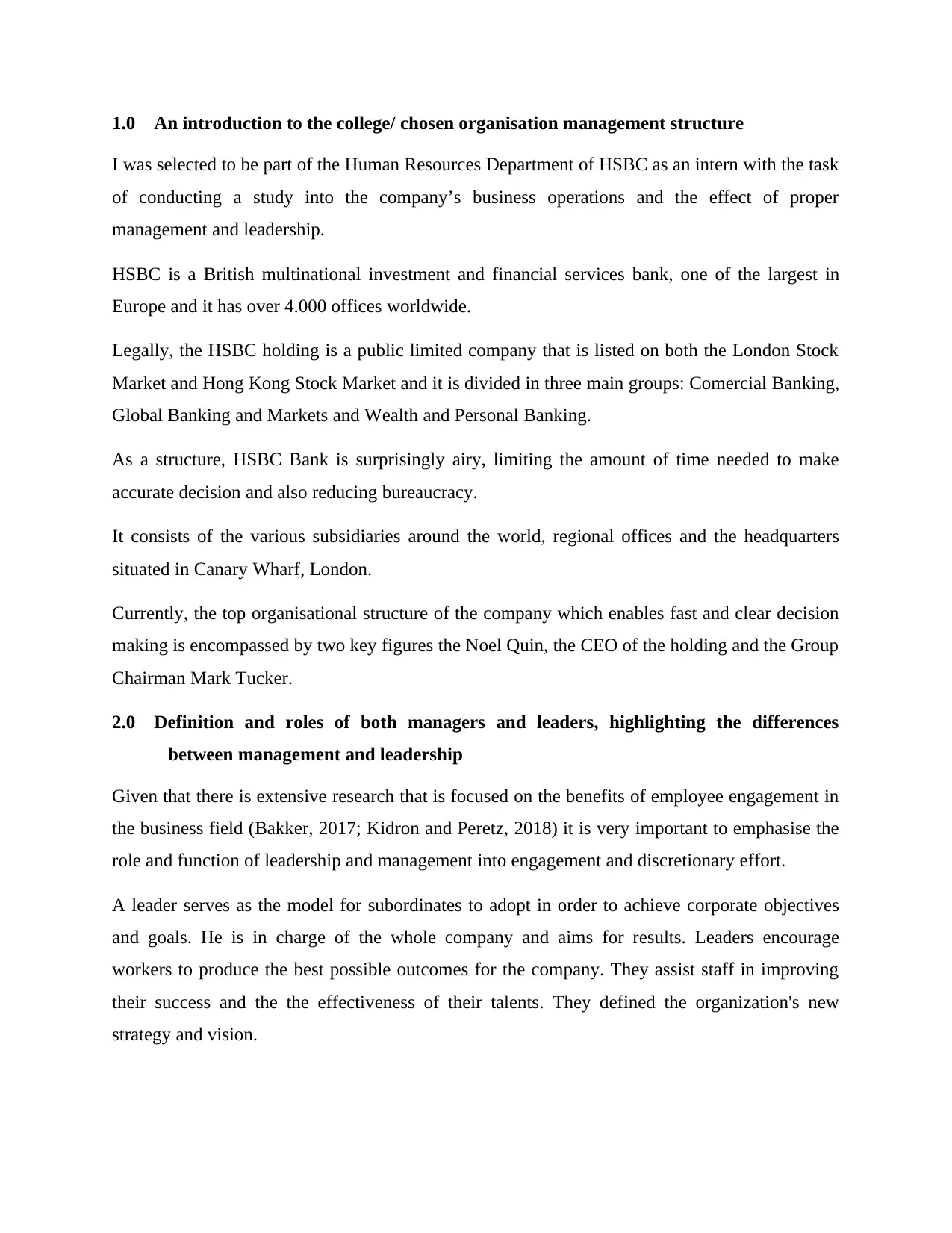
1.0 An introduction to the college/ chosen organisation management structure
I was selected to be part of the Human Resources Department of HSBC as an intern with the task
of conducting a study into the company’s business operations and the effect of proper
management and leadership.
HSBC is a British multinational investment and financial services bank, one of the largest in
Europe and it has over 4.000 offices worldwide.
Legally, the HSBC holding is a public limited company that is listed on both the London Stock
Market and Hong Kong Stock Market and it is divided in three main groups: Comercial Banking,
Global Banking and Markets and Wealth and Personal Banking.
As a structure, HSBC Bank is surprisingly airy, limiting the amount of time needed to make
accurate decision and also reducing bureaucracy.
It consists of the various subsidiaries around the world, regional offices and the headquarters
situated in Canary Wharf, London.
Currently, the top organisational structure of the company which enables fast and clear decision
making is encompassed by two key figures the Noel Quin, the CEO of the holding and the Group
Chairman Mark Tucker.
2.0 Definition and roles of both managers and leaders, highlighting the differences
between management and leadership
Given that there is extensive research that is focused on the benefits of employee engagement in
the business field (Bakker, 2017; Kidron and Peretz, 2018) it is very important to emphasise the
role and function of leadership and management into engagement and discretionary effort.
A leader serves as the model for subordinates to adopt in order to achieve corporate objectives
and goals. He is in charge of the whole company and aims for results. Leaders encourage
workers to produce the best possible outcomes for the company. They assist staff in improving
their success and the the effectiveness of their talents. They defined the organization's new
strategy and vision.
I was selected to be part of the Human Resources Department of HSBC as an intern with the task
of conducting a study into the company’s business operations and the effect of proper
management and leadership.
HSBC is a British multinational investment and financial services bank, one of the largest in
Europe and it has over 4.000 offices worldwide.
Legally, the HSBC holding is a public limited company that is listed on both the London Stock
Market and Hong Kong Stock Market and it is divided in three main groups: Comercial Banking,
Global Banking and Markets and Wealth and Personal Banking.
As a structure, HSBC Bank is surprisingly airy, limiting the amount of time needed to make
accurate decision and also reducing bureaucracy.
It consists of the various subsidiaries around the world, regional offices and the headquarters
situated in Canary Wharf, London.
Currently, the top organisational structure of the company which enables fast and clear decision
making is encompassed by two key figures the Noel Quin, the CEO of the holding and the Group
Chairman Mark Tucker.
2.0 Definition and roles of both managers and leaders, highlighting the differences
between management and leadership
Given that there is extensive research that is focused on the benefits of employee engagement in
the business field (Bakker, 2017; Kidron and Peretz, 2018) it is very important to emphasise the
role and function of leadership and management into engagement and discretionary effort.
A leader serves as the model for subordinates to adopt in order to achieve corporate objectives
and goals. He is in charge of the whole company and aims for results. Leaders encourage
workers to produce the best possible outcomes for the company. They assist staff in improving
their success and the the effectiveness of their talents. They defined the organization's new
strategy and vision.
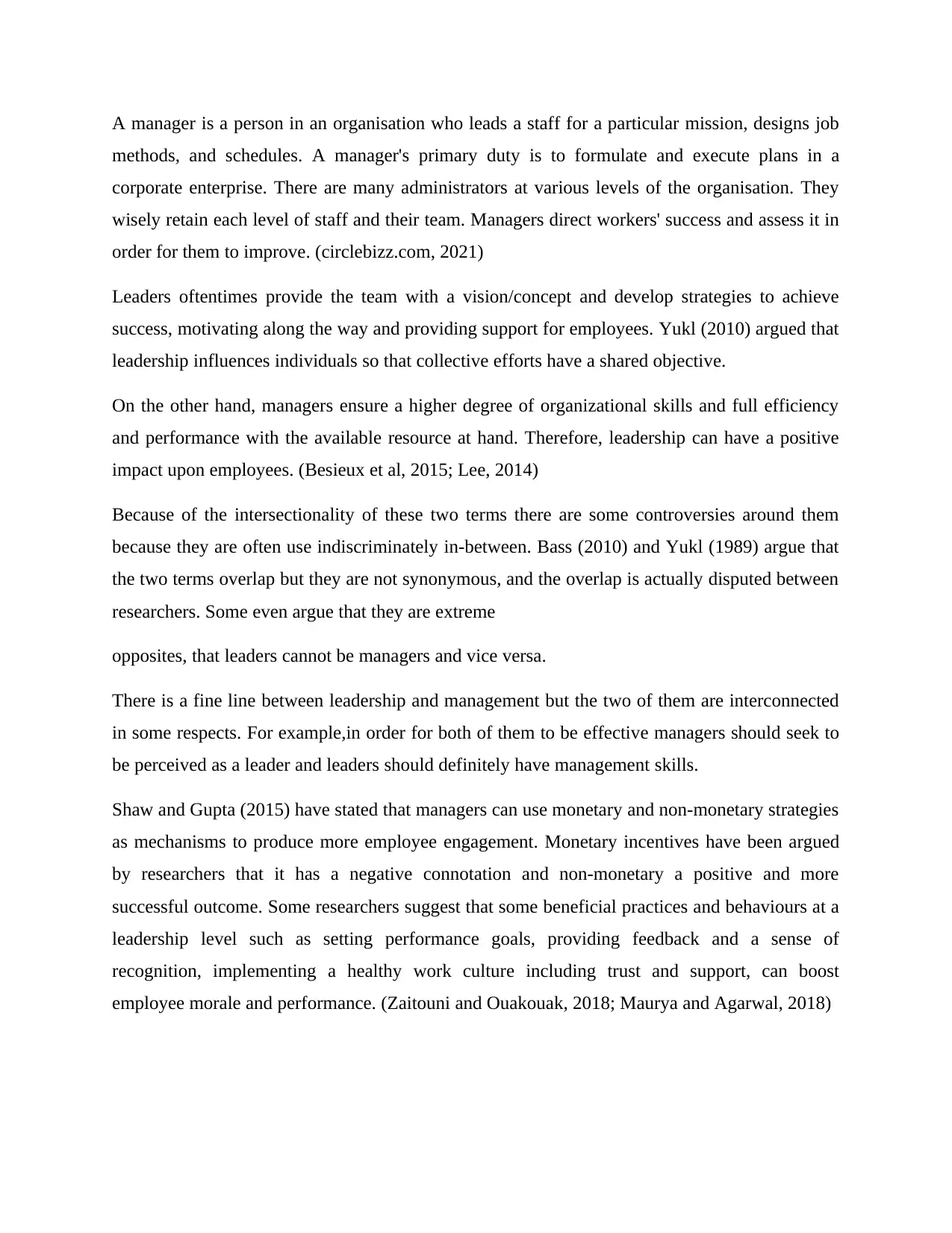
A manager is a person in an organisation who leads a staff for a particular mission, designs job
methods, and schedules. A manager's primary duty is to formulate and execute plans in a
corporate enterprise. There are many administrators at various levels of the organisation. They
wisely retain each level of staff and their team. Managers direct workers' success and assess it in
order for them to improve. (circlebizz.com, 2021)
Leaders oftentimes provide the team with a vision/concept and develop strategies to achieve
success, motivating along the way and providing support for employees. Yukl (2010) argued that
leadership influences individuals so that collective efforts have a shared objective.
On the other hand, managers ensure a higher degree of organizational skills and full efficiency
and performance with the available resource at hand. Therefore, leadership can have a positive
impact upon employees. (Besieux et al, 2015; Lee, 2014)
Because of the intersectionality of these two terms there are some controversies around them
because they are often use indiscriminately in-between. Bass (2010) and Yukl (1989) argue that
the two terms overlap but they are not synonymous, and the overlap is actually disputed between
researchers. Some even argue that they are extreme
opposites, that leaders cannot be managers and vice versa.
There is a fine line between leadership and management but the two of them are interconnected
in some respects. For example,in order for both of them to be effective managers should seek to
be perceived as a leader and leaders should definitely have management skills.
Shaw and Gupta (2015) have stated that managers can use monetary and non-monetary strategies
as mechanisms to produce more employee engagement. Monetary incentives have been argued
by researchers that it has a negative connotation and non-monetary a positive and more
successful outcome. Some researchers suggest that some beneficial practices and behaviours at a
leadership level such as setting performance goals, providing feedback and a sense of
recognition, implementing a healthy work culture including trust and support, can boost
employee morale and performance. (Zaitouni and Ouakouak, 2018; Maurya and Agarwal, 2018)
methods, and schedules. A manager's primary duty is to formulate and execute plans in a
corporate enterprise. There are many administrators at various levels of the organisation. They
wisely retain each level of staff and their team. Managers direct workers' success and assess it in
order for them to improve. (circlebizz.com, 2021)
Leaders oftentimes provide the team with a vision/concept and develop strategies to achieve
success, motivating along the way and providing support for employees. Yukl (2010) argued that
leadership influences individuals so that collective efforts have a shared objective.
On the other hand, managers ensure a higher degree of organizational skills and full efficiency
and performance with the available resource at hand. Therefore, leadership can have a positive
impact upon employees. (Besieux et al, 2015; Lee, 2014)
Because of the intersectionality of these two terms there are some controversies around them
because they are often use indiscriminately in-between. Bass (2010) and Yukl (1989) argue that
the two terms overlap but they are not synonymous, and the overlap is actually disputed between
researchers. Some even argue that they are extreme
opposites, that leaders cannot be managers and vice versa.
There is a fine line between leadership and management but the two of them are interconnected
in some respects. For example,in order for both of them to be effective managers should seek to
be perceived as a leader and leaders should definitely have management skills.
Shaw and Gupta (2015) have stated that managers can use monetary and non-monetary strategies
as mechanisms to produce more employee engagement. Monetary incentives have been argued
by researchers that it has a negative connotation and non-monetary a positive and more
successful outcome. Some researchers suggest that some beneficial practices and behaviours at a
leadership level such as setting performance goals, providing feedback and a sense of
recognition, implementing a healthy work culture including trust and support, can boost
employee morale and performance. (Zaitouni and Ouakouak, 2018; Maurya and Agarwal, 2018)
Secure Best Marks with AI Grader
Need help grading? Try our AI Grader for instant feedback on your assignments.
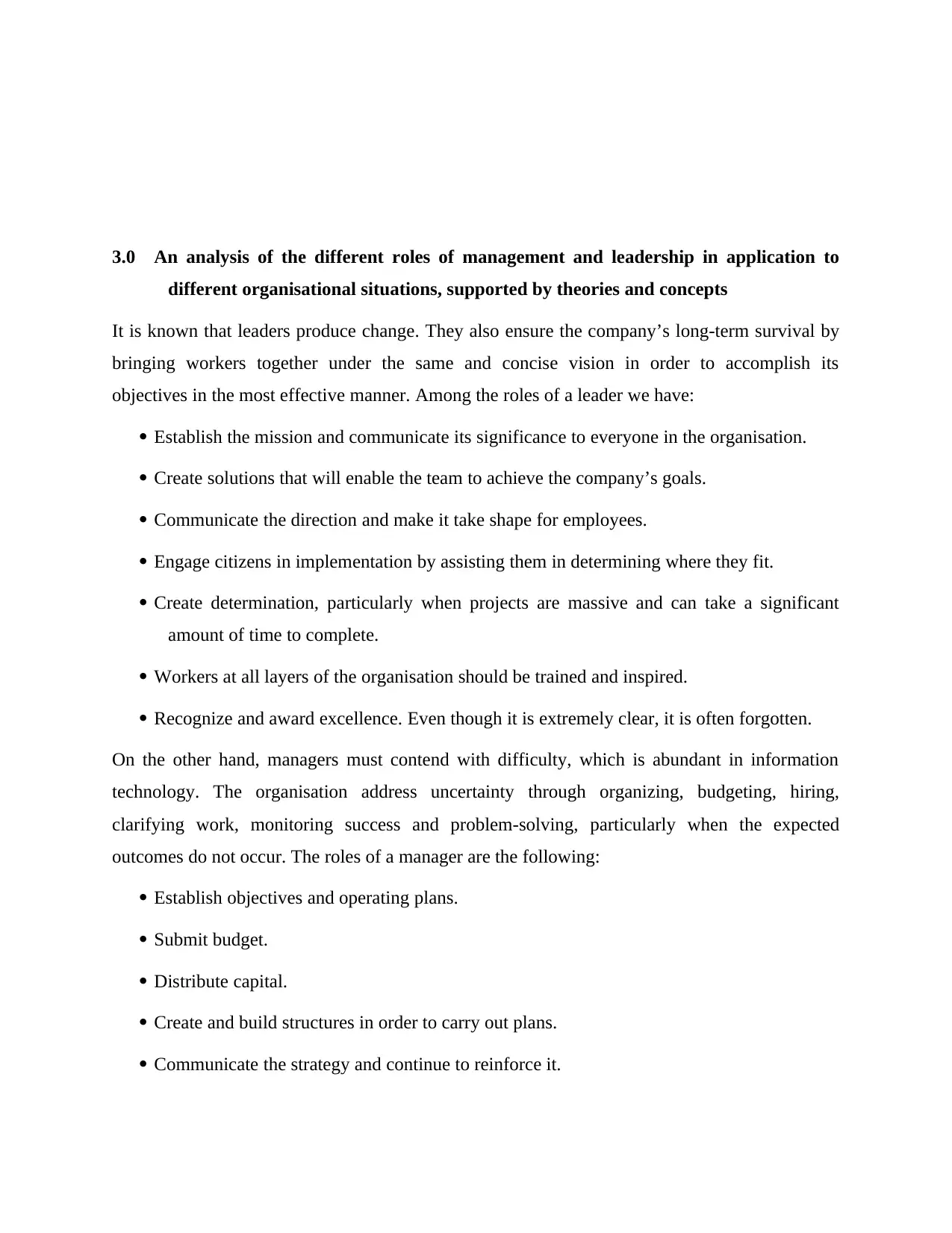
3.0 An analysis of the different roles of management and leadership in application to
different organisational situations, supported by theories and concepts
It is known that leaders produce change. They also ensure the company’s long-term survival by
bringing workers together under the same and concise vision in order to accomplish its
objectives in the most effective manner. Among the roles of a leader we have:
Establish the mission and communicate its significance to everyone in the organisation.
Create solutions that will enable the team to achieve the company’s goals.
Communicate the direction and make it take shape for employees.
Engage citizens in implementation by assisting them in determining where they fit.
Create determination, particularly when projects are massive and can take a significant
amount of time to complete.
Workers at all layers of the organisation should be trained and inspired.
Recognize and award excellence. Even though it is extremely clear, it is often forgotten.
On the other hand, managers must contend with difficulty, which is abundant in information
technology. The organisation address uncertainty through organizing, budgeting, hiring,
clarifying work, monitoring success and problem-solving, particularly when the expected
outcomes do not occur. The roles of a manager are the following:
Establish objectives and operating plans.
Submit budget.
Distribute capital.
Create and build structures in order to carry out plans.
Communicate the strategy and continue to reinforce it.
different organisational situations, supported by theories and concepts
It is known that leaders produce change. They also ensure the company’s long-term survival by
bringing workers together under the same and concise vision in order to accomplish its
objectives in the most effective manner. Among the roles of a leader we have:
Establish the mission and communicate its significance to everyone in the organisation.
Create solutions that will enable the team to achieve the company’s goals.
Communicate the direction and make it take shape for employees.
Engage citizens in implementation by assisting them in determining where they fit.
Create determination, particularly when projects are massive and can take a significant
amount of time to complete.
Workers at all layers of the organisation should be trained and inspired.
Recognize and award excellence. Even though it is extremely clear, it is often forgotten.
On the other hand, managers must contend with difficulty, which is abundant in information
technology. The organisation address uncertainty through organizing, budgeting, hiring,
clarifying work, monitoring success and problem-solving, particularly when the expected
outcomes do not occur. The roles of a manager are the following:
Establish objectives and operating plans.
Submit budget.
Distribute capital.
Create and build structures in order to carry out plans.
Communicate the strategy and continue to reinforce it.
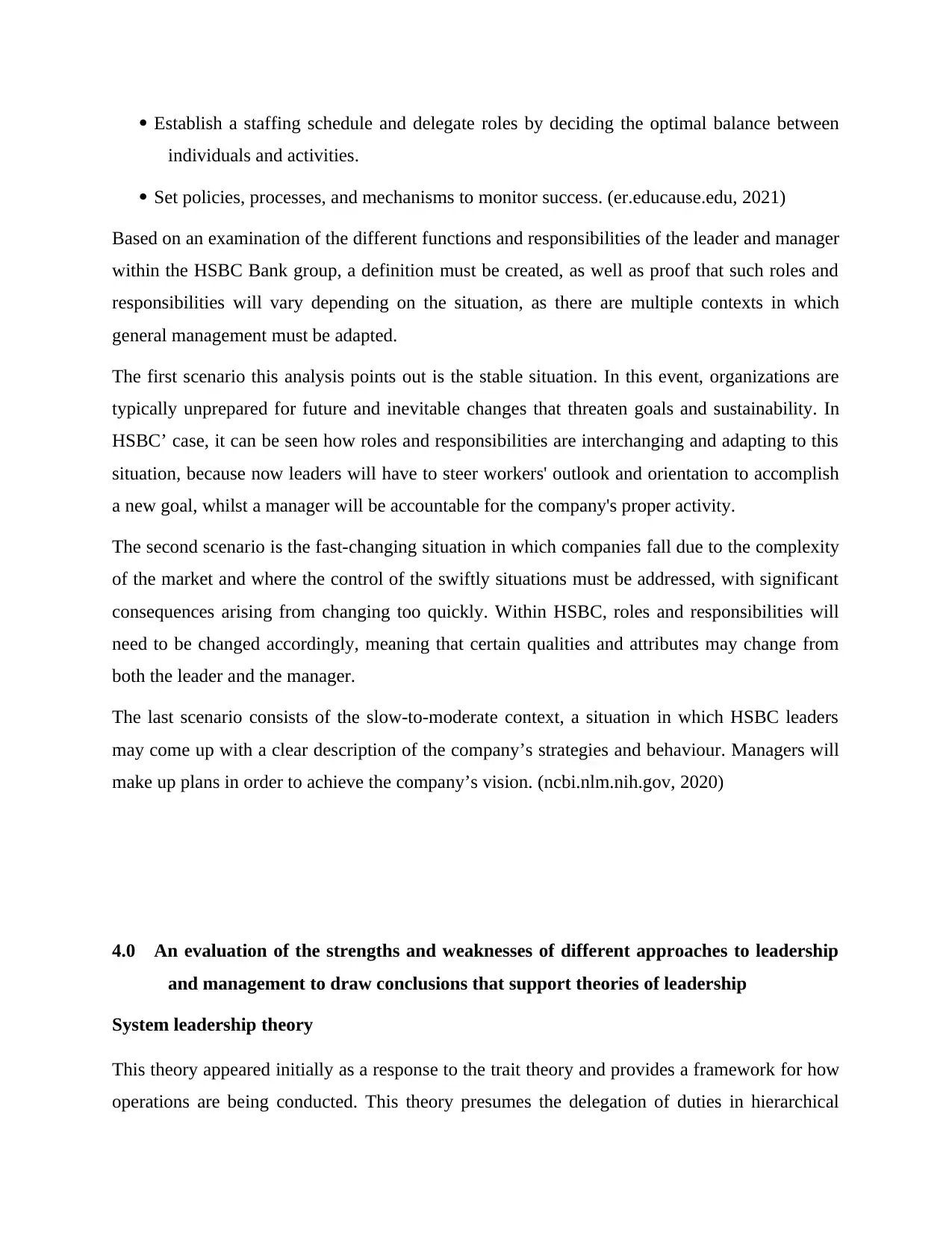
Establish a staffing schedule and delegate roles by deciding the optimal balance between
individuals and activities.
Set policies, processes, and mechanisms to monitor success. (er.educause.edu, 2021)
Based on an examination of the different functions and responsibilities of the leader and manager
within the HSBC Bank group, a definition must be created, as well as proof that such roles and
responsibilities will vary depending on the situation, as there are multiple contexts in which
general management must be adapted.
The first scenario this analysis points out is the stable situation. In this event, organizations are
typically unprepared for future and inevitable changes that threaten goals and sustainability. In
HSBC’ case, it can be seen how roles and responsibilities are interchanging and adapting to this
situation, because now leaders will have to steer workers' outlook and orientation to accomplish
a new goal, whilst a manager will be accountable for the company's proper activity.
The second scenario is the fast-changing situation in which companies fall due to the complexity
of the market and where the control of the swiftly situations must be addressed, with significant
consequences arising from changing too quickly. Within HSBC, roles and responsibilities will
need to be changed accordingly, meaning that certain qualities and attributes may change from
both the leader and the manager.
The last scenario consists of the slow-to-moderate context, a situation in which HSBC leaders
may come up with a clear description of the company’s strategies and behaviour. Managers will
make up plans in order to achieve the company’s vision. (ncbi.nlm.nih.gov, 2020)
4.0 An evaluation of the strengths and weaknesses of different approaches to leadership
and management to draw conclusions that support theories of leadership
System leadership theory
This theory appeared initially as a response to the trait theory and provides a framework for how
operations are being conducted. This theory presumes the delegation of duties in hierarchical
individuals and activities.
Set policies, processes, and mechanisms to monitor success. (er.educause.edu, 2021)
Based on an examination of the different functions and responsibilities of the leader and manager
within the HSBC Bank group, a definition must be created, as well as proof that such roles and
responsibilities will vary depending on the situation, as there are multiple contexts in which
general management must be adapted.
The first scenario this analysis points out is the stable situation. In this event, organizations are
typically unprepared for future and inevitable changes that threaten goals and sustainability. In
HSBC’ case, it can be seen how roles and responsibilities are interchanging and adapting to this
situation, because now leaders will have to steer workers' outlook and orientation to accomplish
a new goal, whilst a manager will be accountable for the company's proper activity.
The second scenario is the fast-changing situation in which companies fall due to the complexity
of the market and where the control of the swiftly situations must be addressed, with significant
consequences arising from changing too quickly. Within HSBC, roles and responsibilities will
need to be changed accordingly, meaning that certain qualities and attributes may change from
both the leader and the manager.
The last scenario consists of the slow-to-moderate context, a situation in which HSBC leaders
may come up with a clear description of the company’s strategies and behaviour. Managers will
make up plans in order to achieve the company’s vision. (ncbi.nlm.nih.gov, 2020)
4.0 An evaluation of the strengths and weaknesses of different approaches to leadership
and management to draw conclusions that support theories of leadership
System leadership theory
This theory appeared initially as a response to the trait theory and provides a framework for how
operations are being conducted. This theory presumes the delegation of duties in hierarchical
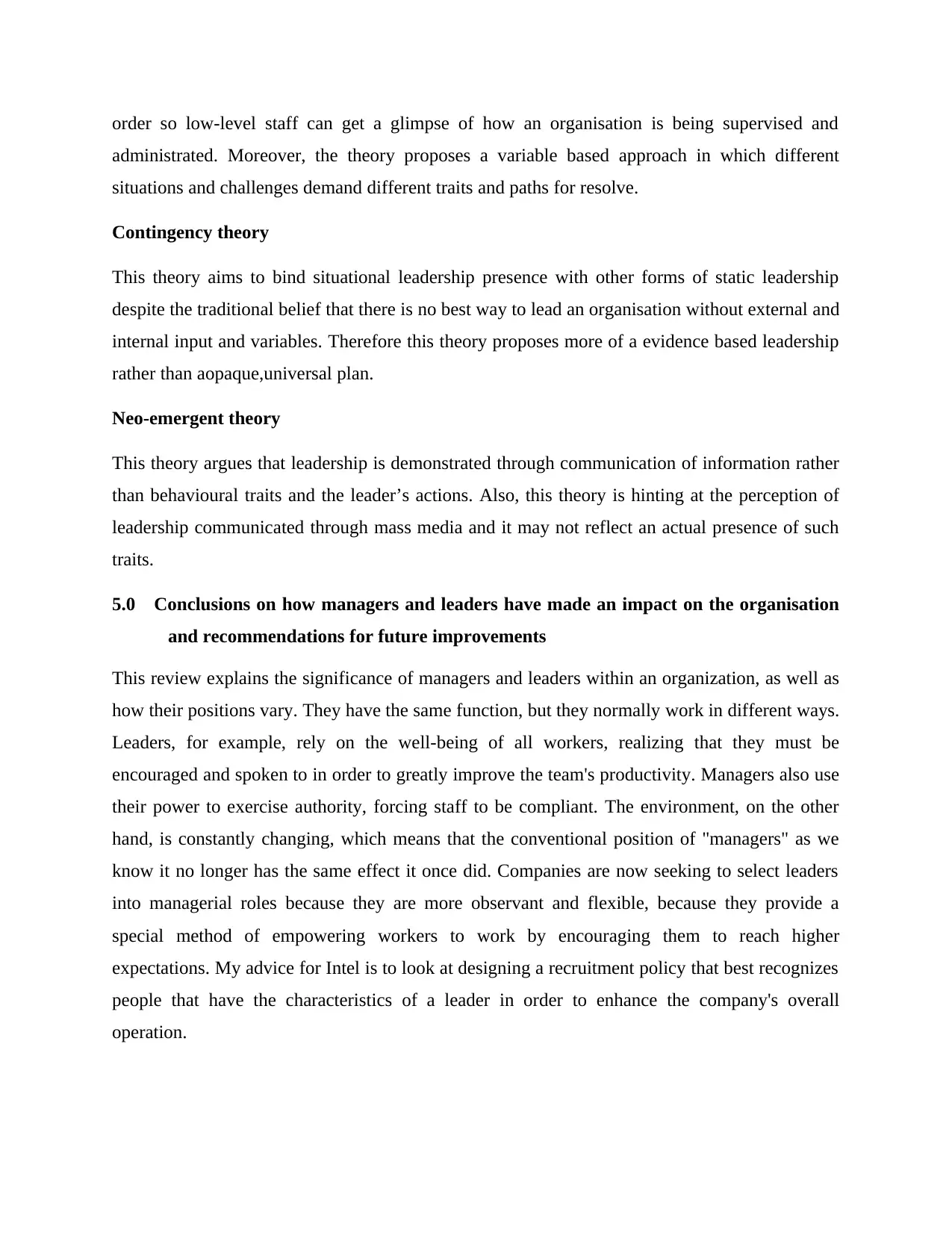
order so low-level staff can get a glimpse of how an organisation is being supervised and
administrated. Moreover, the theory proposes a variable based approach in which different
situations and challenges demand different traits and paths for resolve.
Contingency theory
This theory aims to bind situational leadership presence with other forms of static leadership
despite the traditional belief that there is no best way to lead an organisation without external and
internal input and variables. Therefore this theory proposes more of a evidence based leadership
rather than aopaque,universal plan.
Neo-emergent theory
This theory argues that leadership is demonstrated through communication of information rather
than behavioural traits and the leader’s actions. Also, this theory is hinting at the perception of
leadership communicated through mass media and it may not reflect an actual presence of such
traits.
5.0 Conclusions on how managers and leaders have made an impact on the organisation
and recommendations for future improvements
This review explains the significance of managers and leaders within an organization, as well as
how their positions vary. They have the same function, but they normally work in different ways.
Leaders, for example, rely on the well-being of all workers, realizing that they must be
encouraged and spoken to in order to greatly improve the team's productivity. Managers also use
their power to exercise authority, forcing staff to be compliant. The environment, on the other
hand, is constantly changing, which means that the conventional position of "managers" as we
know it no longer has the same effect it once did. Companies are now seeking to select leaders
into managerial roles because they are more observant and flexible, because they provide a
special method of empowering workers to work by encouraging them to reach higher
expectations. My advice for Intel is to look at designing a recruitment policy that best recognizes
people that have the characteristics of a leader in order to enhance the company's overall
operation.
administrated. Moreover, the theory proposes a variable based approach in which different
situations and challenges demand different traits and paths for resolve.
Contingency theory
This theory aims to bind situational leadership presence with other forms of static leadership
despite the traditional belief that there is no best way to lead an organisation without external and
internal input and variables. Therefore this theory proposes more of a evidence based leadership
rather than aopaque,universal plan.
Neo-emergent theory
This theory argues that leadership is demonstrated through communication of information rather
than behavioural traits and the leader’s actions. Also, this theory is hinting at the perception of
leadership communicated through mass media and it may not reflect an actual presence of such
traits.
5.0 Conclusions on how managers and leaders have made an impact on the organisation
and recommendations for future improvements
This review explains the significance of managers and leaders within an organization, as well as
how their positions vary. They have the same function, but they normally work in different ways.
Leaders, for example, rely on the well-being of all workers, realizing that they must be
encouraged and spoken to in order to greatly improve the team's productivity. Managers also use
their power to exercise authority, forcing staff to be compliant. The environment, on the other
hand, is constantly changing, which means that the conventional position of "managers" as we
know it no longer has the same effect it once did. Companies are now seeking to select leaders
into managerial roles because they are more observant and flexible, because they provide a
special method of empowering workers to work by encouraging them to reach higher
expectations. My advice for Intel is to look at designing a recruitment policy that best recognizes
people that have the characteristics of a leader in order to enhance the company's overall
operation.
Paraphrase This Document
Need a fresh take? Get an instant paraphrase of this document with our AI Paraphraser
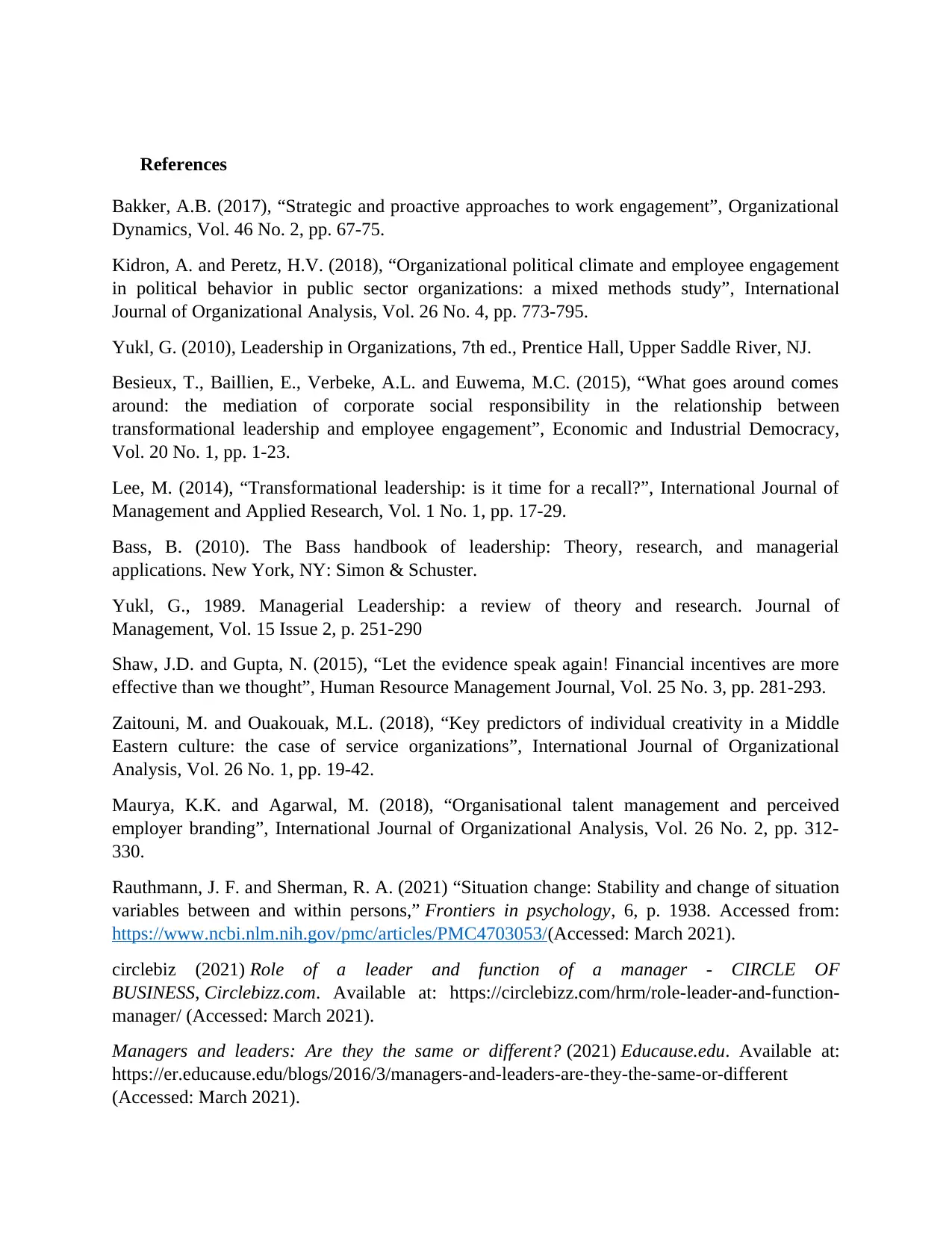
References
Bakker, A.B. (2017), “Strategic and proactive approaches to work engagement”, Organizational
Dynamics, Vol. 46 No. 2, pp. 67-75.
Kidron, A. and Peretz, H.V. (2018), “Organizational political climate and employee engagement
in political behavior in public sector organizations: a mixed methods study”, International
Journal of Organizational Analysis, Vol. 26 No. 4, pp. 773-795.
Yukl, G. (2010), Leadership in Organizations, 7th ed., Prentice Hall, Upper Saddle River, NJ.
Besieux, T., Baillien, E., Verbeke, A.L. and Euwema, M.C. (2015), “What goes around comes
around: the mediation of corporate social responsibility in the relationship between
transformational leadership and employee engagement”, Economic and Industrial Democracy,
Vol. 20 No. 1, pp. 1-23.
Lee, M. (2014), “Transformational leadership: is it time for a recall?”, International Journal of
Management and Applied Research, Vol. 1 No. 1, pp. 17-29.
Bass, B. (2010). The Bass handbook of leadership: Theory, research, and managerial
applications. New York, NY: Simon & Schuster.
Yukl, G., 1989. Managerial Leadership: a review of theory and research. Journal of
Management, Vol. 15 Issue 2, p. 251-290
Shaw, J.D. and Gupta, N. (2015), “Let the evidence speak again! Financial incentives are more
effective than we thought”, Human Resource Management Journal, Vol. 25 No. 3, pp. 281-293.
Zaitouni, M. and Ouakouak, M.L. (2018), “Key predictors of individual creativity in a Middle
Eastern culture: the case of service organizations”, International Journal of Organizational
Analysis, Vol. 26 No. 1, pp. 19-42.
Maurya, K.K. and Agarwal, M. (2018), “Organisational talent management and perceived
employer branding”, International Journal of Organizational Analysis, Vol. 26 No. 2, pp. 312-
330.
Rauthmann, J. F. and Sherman, R. A. (2021) “Situation change: Stability and change of situation
variables between and within persons,” Frontiers in psychology, 6, p. 1938. Accessed from:
https://www.ncbi.nlm.nih.gov/pmc/articles/PMC4703053/(Accessed: March 2021).
circlebiz (2021) Role of a leader and function of a manager - CIRCLE OF
BUSINESS, Circlebizz.com. Available at: https://circlebizz.com/hrm/role-leader-and-function-
manager/ (Accessed: March 2021).
Managers and leaders: Are they the same or different? (2021) Educause.edu. Available at:
https://er.educause.edu/blogs/2016/3/managers-and-leaders-are-they-the-same-or-different
(Accessed: March 2021).
Bakker, A.B. (2017), “Strategic and proactive approaches to work engagement”, Organizational
Dynamics, Vol. 46 No. 2, pp. 67-75.
Kidron, A. and Peretz, H.V. (2018), “Organizational political climate and employee engagement
in political behavior in public sector organizations: a mixed methods study”, International
Journal of Organizational Analysis, Vol. 26 No. 4, pp. 773-795.
Yukl, G. (2010), Leadership in Organizations, 7th ed., Prentice Hall, Upper Saddle River, NJ.
Besieux, T., Baillien, E., Verbeke, A.L. and Euwema, M.C. (2015), “What goes around comes
around: the mediation of corporate social responsibility in the relationship between
transformational leadership and employee engagement”, Economic and Industrial Democracy,
Vol. 20 No. 1, pp. 1-23.
Lee, M. (2014), “Transformational leadership: is it time for a recall?”, International Journal of
Management and Applied Research, Vol. 1 No. 1, pp. 17-29.
Bass, B. (2010). The Bass handbook of leadership: Theory, research, and managerial
applications. New York, NY: Simon & Schuster.
Yukl, G., 1989. Managerial Leadership: a review of theory and research. Journal of
Management, Vol. 15 Issue 2, p. 251-290
Shaw, J.D. and Gupta, N. (2015), “Let the evidence speak again! Financial incentives are more
effective than we thought”, Human Resource Management Journal, Vol. 25 No. 3, pp. 281-293.
Zaitouni, M. and Ouakouak, M.L. (2018), “Key predictors of individual creativity in a Middle
Eastern culture: the case of service organizations”, International Journal of Organizational
Analysis, Vol. 26 No. 1, pp. 19-42.
Maurya, K.K. and Agarwal, M. (2018), “Organisational talent management and perceived
employer branding”, International Journal of Organizational Analysis, Vol. 26 No. 2, pp. 312-
330.
Rauthmann, J. F. and Sherman, R. A. (2021) “Situation change: Stability and change of situation
variables between and within persons,” Frontiers in psychology, 6, p. 1938. Accessed from:
https://www.ncbi.nlm.nih.gov/pmc/articles/PMC4703053/(Accessed: March 2021).
circlebiz (2021) Role of a leader and function of a manager - CIRCLE OF
BUSINESS, Circlebizz.com. Available at: https://circlebizz.com/hrm/role-leader-and-function-
manager/ (Accessed: March 2021).
Managers and leaders: Are they the same or different? (2021) Educause.edu. Available at:
https://er.educause.edu/blogs/2016/3/managers-and-leaders-are-they-the-same-or-different
(Accessed: March 2021).
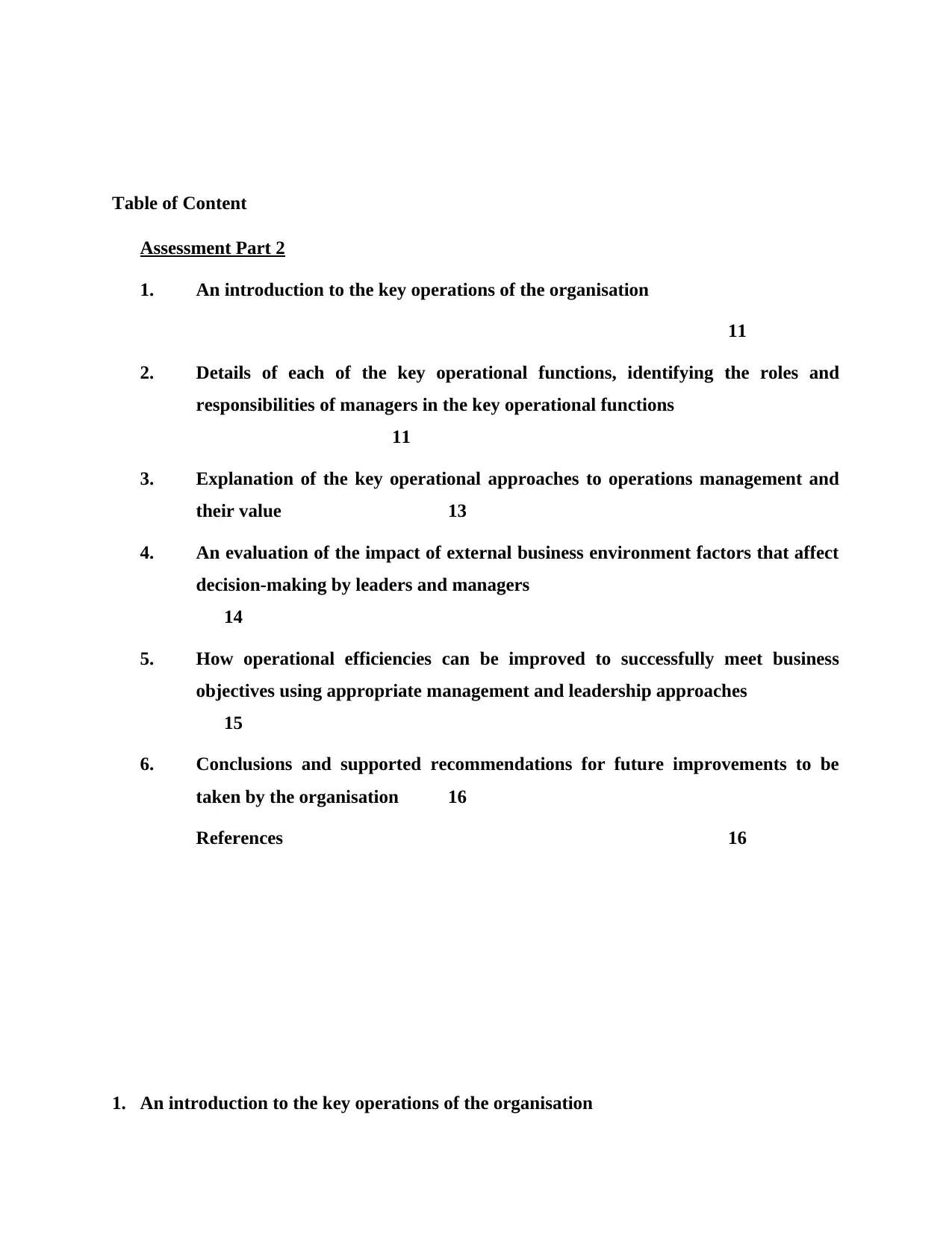
Table of Content
Assessment Part 2
1. An introduction to the key operations of the organisation
11
2. Details of each of the key operational functions, identifying the roles and
responsibilities of managers in the key operational functions
11
3. Explanation of the key operational approaches to operations management and
their value 13
4. An evaluation of the impact of external business environment factors that affect
decision-making by leaders and managers
14
5. How operational efficiencies can be improved to successfully meet business
objectives using appropriate management and leadership approaches
15
6. Conclusions and supported recommendations for future improvements to be
taken by the organisation 16
References 16
1. An introduction to the key operations of the organisation
Assessment Part 2
1. An introduction to the key operations of the organisation
11
2. Details of each of the key operational functions, identifying the roles and
responsibilities of managers in the key operational functions
11
3. Explanation of the key operational approaches to operations management and
their value 13
4. An evaluation of the impact of external business environment factors that affect
decision-making by leaders and managers
14
5. How operational efficiencies can be improved to successfully meet business
objectives using appropriate management and leadership approaches
15
6. Conclusions and supported recommendations for future improvements to be
taken by the organisation 16
References 16
1. An introduction to the key operations of the organisation
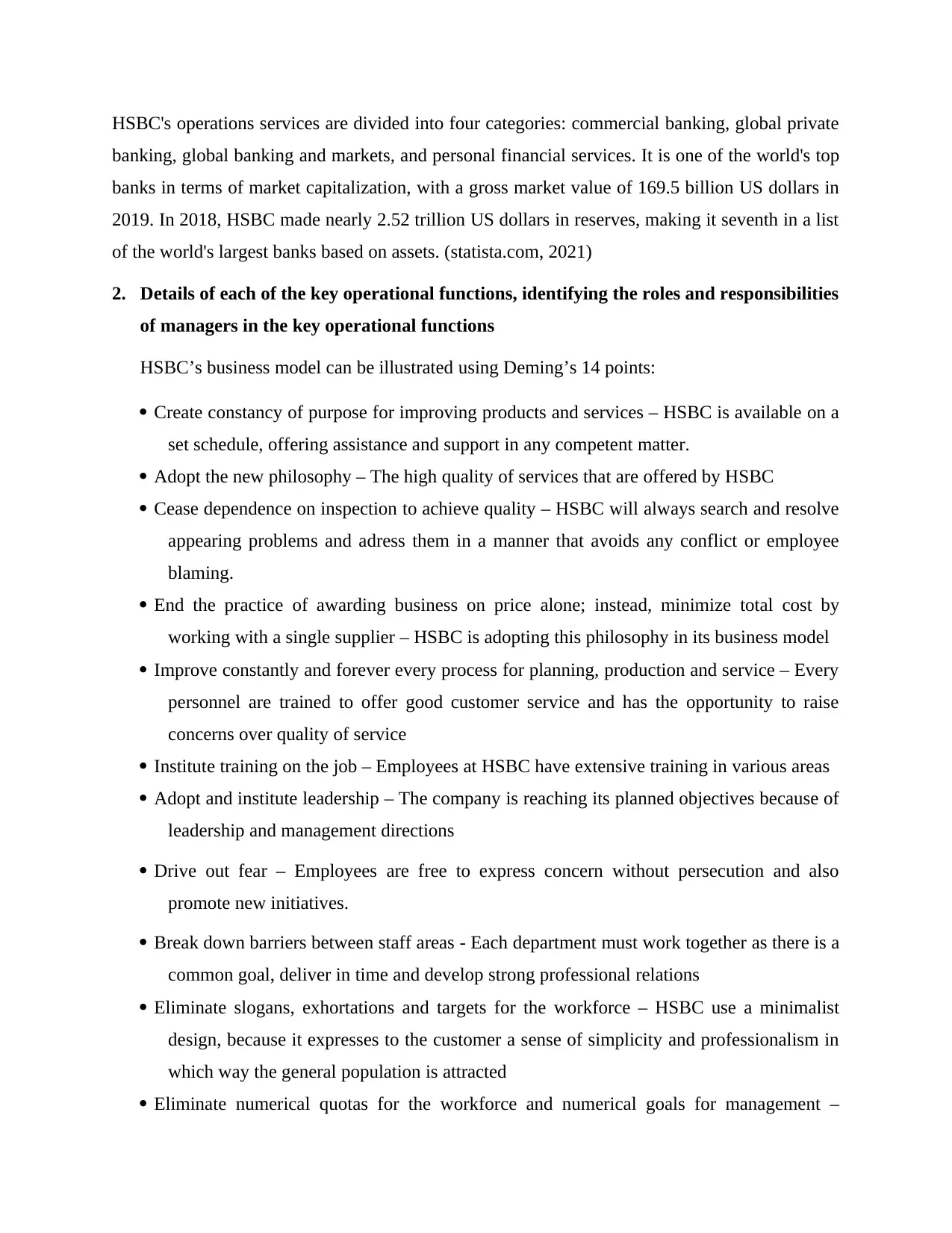
HSBC's operations services are divided into four categories: commercial banking, global private
banking, global banking and markets, and personal financial services. It is one of the world's top
banks in terms of market capitalization, with a gross market value of 169.5 billion US dollars in
2019. In 2018, HSBC made nearly 2.52 trillion US dollars in reserves, making it seventh in a list
of the world's largest banks based on assets. (statista.com, 2021)
2. Details of each of the key operational functions, identifying the roles and responsibilities
of managers in the key operational functions
HSBC’s business model can be illustrated using Deming’s 14 points:
Create constancy of purpose for improving products and services – HSBC is available on a
set schedule, offering assistance and support in any competent matter.
Adopt the new philosophy – The high quality of services that are offered by HSBC
Cease dependence on inspection to achieve quality – HSBC will always search and resolve
appearing problems and adress them in a manner that avoids any conflict or employee
blaming.
End the practice of awarding business on price alone; instead, minimize total cost by
working with a single supplier – HSBC is adopting this philosophy in its business model
Improve constantly and forever every process for planning, production and service – Every
personnel are trained to offer good customer service and has the opportunity to raise
concerns over quality of service
Institute training on the job – Employees at HSBC have extensive training in various areas
Adopt and institute leadership – The company is reaching its planned objectives because of
leadership and management directions
Drive out fear – Employees are free to express concern without persecution and also
promote new initiatives.
Break down barriers between staff areas - Each department must work together as there is a
common goal, deliver in time and develop strong professional relations
Eliminate slogans, exhortations and targets for the workforce – HSBC use a minimalist
design, because it expresses to the customer a sense of simplicity and professionalism in
which way the general population is attracted
Eliminate numerical quotas for the workforce and numerical goals for management –
banking, global banking and markets, and personal financial services. It is one of the world's top
banks in terms of market capitalization, with a gross market value of 169.5 billion US dollars in
2019. In 2018, HSBC made nearly 2.52 trillion US dollars in reserves, making it seventh in a list
of the world's largest banks based on assets. (statista.com, 2021)
2. Details of each of the key operational functions, identifying the roles and responsibilities
of managers in the key operational functions
HSBC’s business model can be illustrated using Deming’s 14 points:
Create constancy of purpose for improving products and services – HSBC is available on a
set schedule, offering assistance and support in any competent matter.
Adopt the new philosophy – The high quality of services that are offered by HSBC
Cease dependence on inspection to achieve quality – HSBC will always search and resolve
appearing problems and adress them in a manner that avoids any conflict or employee
blaming.
End the practice of awarding business on price alone; instead, minimize total cost by
working with a single supplier – HSBC is adopting this philosophy in its business model
Improve constantly and forever every process for planning, production and service – Every
personnel are trained to offer good customer service and has the opportunity to raise
concerns over quality of service
Institute training on the job – Employees at HSBC have extensive training in various areas
Adopt and institute leadership – The company is reaching its planned objectives because of
leadership and management directions
Drive out fear – Employees are free to express concern without persecution and also
promote new initiatives.
Break down barriers between staff areas - Each department must work together as there is a
common goal, deliver in time and develop strong professional relations
Eliminate slogans, exhortations and targets for the workforce – HSBC use a minimalist
design, because it expresses to the customer a sense of simplicity and professionalism in
which way the general population is attracted
Eliminate numerical quotas for the workforce and numerical goals for management –
Secure Best Marks with AI Grader
Need help grading? Try our AI Grader for instant feedback on your assignments.
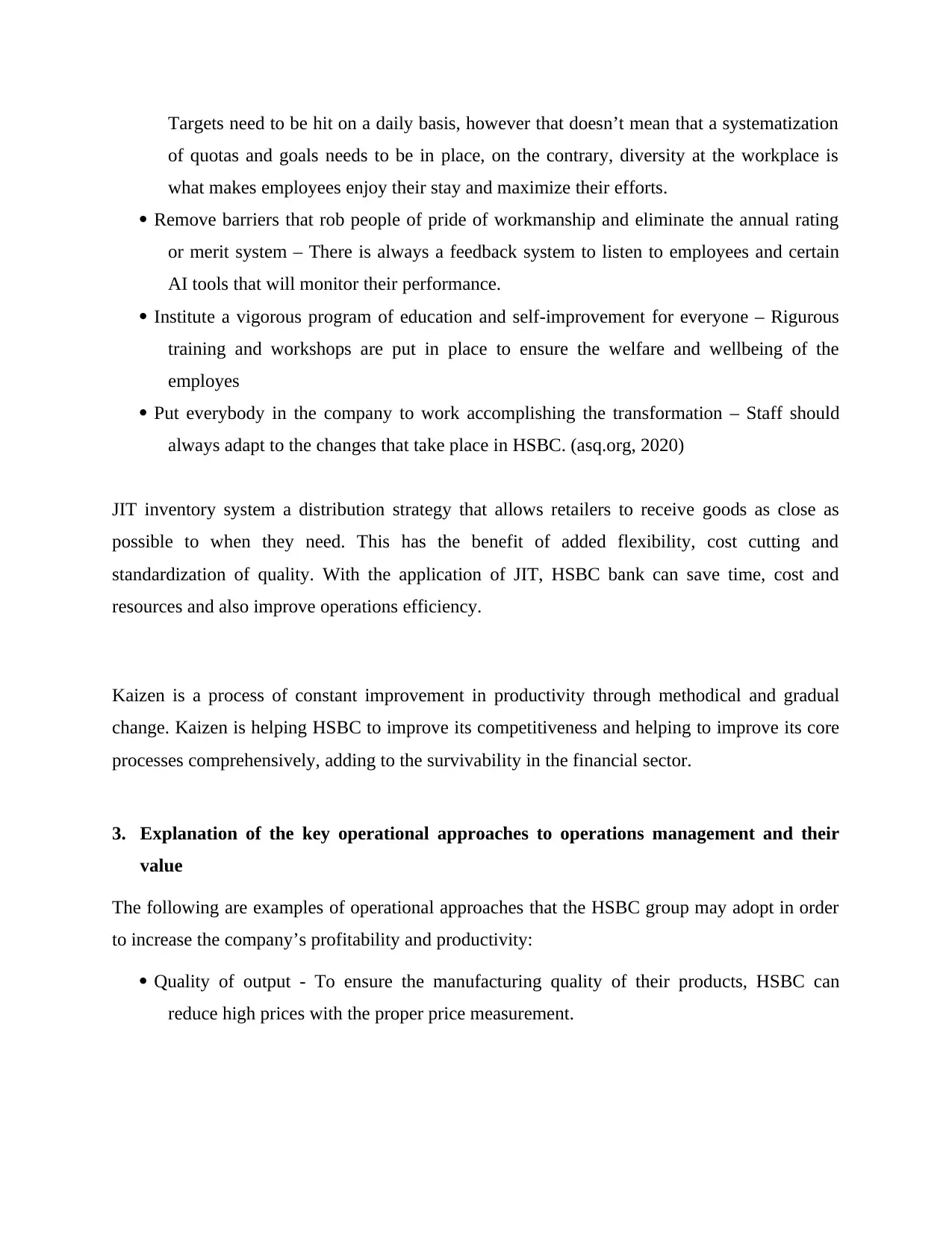
Targets need to be hit on a daily basis, however that doesn’t mean that a systematization
of quotas and goals needs to be in place, on the contrary, diversity at the workplace is
what makes employees enjoy their stay and maximize their efforts.
Remove barriers that rob people of pride of workmanship and eliminate the annual rating
or merit system – There is always a feedback system to listen to employees and certain
AI tools that will monitor their performance.
Institute a vigorous program of education and self-improvement for everyone – Rigurous
training and workshops are put in place to ensure the welfare and wellbeing of the
employes
Put everybody in the company to work accomplishing the transformation – Staff should
always adapt to the changes that take place in HSBC. (asq.org, 2020)
JIT inventory system a distribution strategy that allows retailers to receive goods as close as
possible to when they need. This has the benefit of added flexibility, cost cutting and
standardization of quality. With the application of JIT, HSBC bank can save time, cost and
resources and also improve operations efficiency.
Kaizen is a process of constant improvement in productivity through methodical and gradual
change. Kaizen is helping HSBC to improve its competitiveness and helping to improve its core
processes comprehensively, adding to the survivability in the financial sector.
3. Explanation of the key operational approaches to operations management and their
value
The following are examples of operational approaches that the HSBC group may adopt in order
to increase the company’s profitability and productivity:
Quality of output - To ensure the manufacturing quality of their products, HSBC can
reduce high prices with the proper price measurement.
of quotas and goals needs to be in place, on the contrary, diversity at the workplace is
what makes employees enjoy their stay and maximize their efforts.
Remove barriers that rob people of pride of workmanship and eliminate the annual rating
or merit system – There is always a feedback system to listen to employees and certain
AI tools that will monitor their performance.
Institute a vigorous program of education and self-improvement for everyone – Rigurous
training and workshops are put in place to ensure the welfare and wellbeing of the
employes
Put everybody in the company to work accomplishing the transformation – Staff should
always adapt to the changes that take place in HSBC. (asq.org, 2020)
JIT inventory system a distribution strategy that allows retailers to receive goods as close as
possible to when they need. This has the benefit of added flexibility, cost cutting and
standardization of quality. With the application of JIT, HSBC bank can save time, cost and
resources and also improve operations efficiency.
Kaizen is a process of constant improvement in productivity through methodical and gradual
change. Kaizen is helping HSBC to improve its competitiveness and helping to improve its core
processes comprehensively, adding to the survivability in the financial sector.
3. Explanation of the key operational approaches to operations management and their
value
The following are examples of operational approaches that the HSBC group may adopt in order
to increase the company’s profitability and productivity:
Quality of output - To ensure the manufacturing quality of their products, HSBC can
reduce high prices with the proper price measurement.
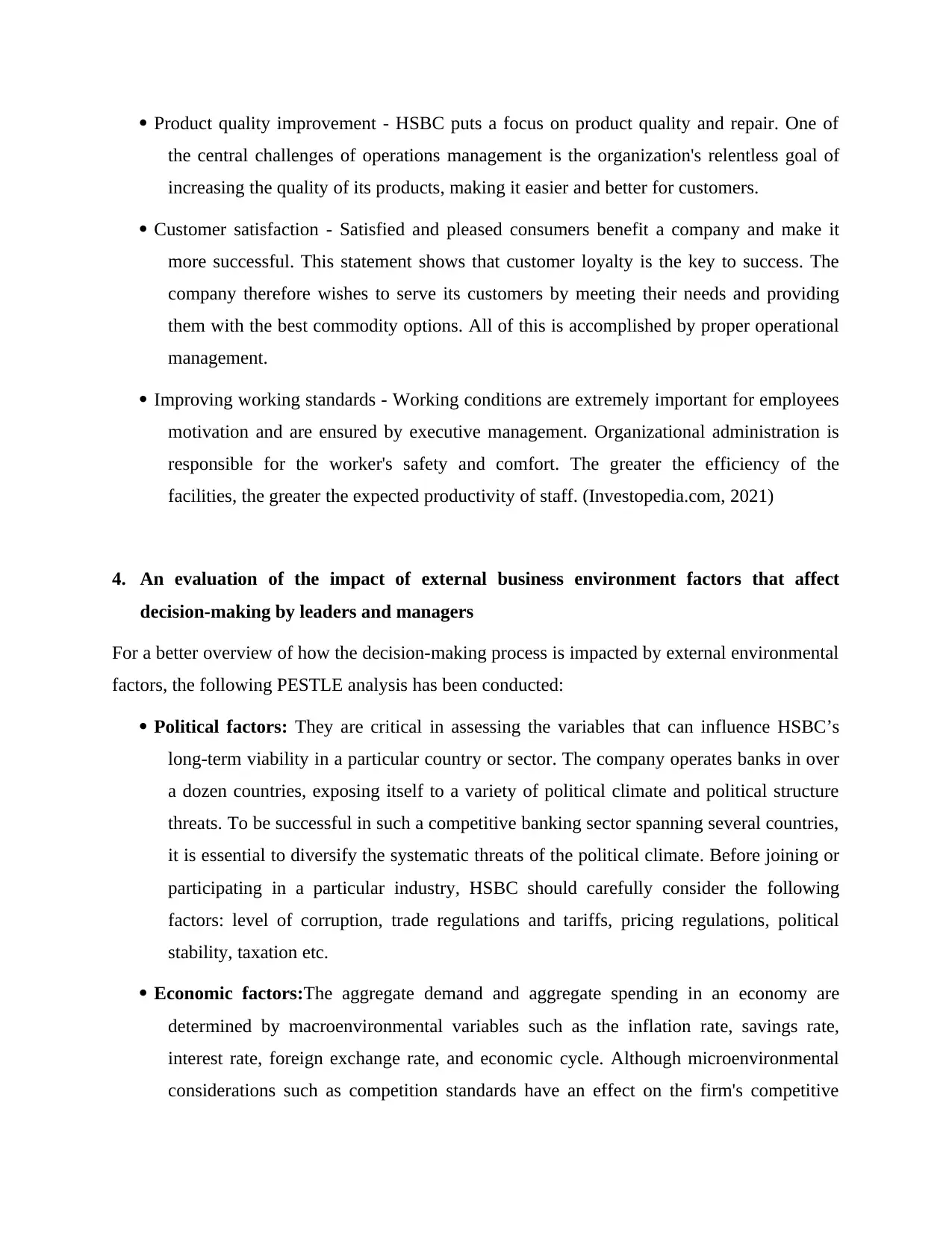
Product quality improvement - HSBC puts a focus on product quality and repair. One of
the central challenges of operations management is the organization's relentless goal of
increasing the quality of its products, making it easier and better for customers.
Customer satisfaction - Satisfied and pleased consumers benefit a company and make it
more successful. This statement shows that customer loyalty is the key to success. The
company therefore wishes to serve its customers by meeting their needs and providing
them with the best commodity options. All of this is accomplished by proper operational
management.
Improving working standards - Working conditions are extremely important for employees
motivation and are ensured by executive management. Organizational administration is
responsible for the worker's safety and comfort. The greater the efficiency of the
facilities, the greater the expected productivity of staff. (Investopedia.com, 2021)
4. An evaluation of the impact of external business environment factors that affect
decision-making by leaders and managers
For a better overview of how the decision-making process is impacted by external environmental
factors, the following PESTLE analysis has been conducted:
Political factors: They are critical in assessing the variables that can influence HSBC’s
long-term viability in a particular country or sector. The company operates banks in over
a dozen countries, exposing itself to a variety of political climate and political structure
threats. To be successful in such a competitive banking sector spanning several countries,
it is essential to diversify the systematic threats of the political climate. Before joining or
participating in a particular industry, HSBC should carefully consider the following
factors: level of corruption, trade regulations and tariffs, pricing regulations, political
stability, taxation etc.
Economic factors:The aggregate demand and aggregate spending in an economy are
determined by macroenvironmental variables such as the inflation rate, savings rate,
interest rate, foreign exchange rate, and economic cycle. Although microenvironmental
considerations such as competition standards have an effect on the firm's competitive
the central challenges of operations management is the organization's relentless goal of
increasing the quality of its products, making it easier and better for customers.
Customer satisfaction - Satisfied and pleased consumers benefit a company and make it
more successful. This statement shows that customer loyalty is the key to success. The
company therefore wishes to serve its customers by meeting their needs and providing
them with the best commodity options. All of this is accomplished by proper operational
management.
Improving working standards - Working conditions are extremely important for employees
motivation and are ensured by executive management. Organizational administration is
responsible for the worker's safety and comfort. The greater the efficiency of the
facilities, the greater the expected productivity of staff. (Investopedia.com, 2021)
4. An evaluation of the impact of external business environment factors that affect
decision-making by leaders and managers
For a better overview of how the decision-making process is impacted by external environmental
factors, the following PESTLE analysis has been conducted:
Political factors: They are critical in assessing the variables that can influence HSBC’s
long-term viability in a particular country or sector. The company operates banks in over
a dozen countries, exposing itself to a variety of political climate and political structure
threats. To be successful in such a competitive banking sector spanning several countries,
it is essential to diversify the systematic threats of the political climate. Before joining or
participating in a particular industry, HSBC should carefully consider the following
factors: level of corruption, trade regulations and tariffs, pricing regulations, political
stability, taxation etc.
Economic factors:The aggregate demand and aggregate spending in an economy are
determined by macroenvironmental variables such as the inflation rate, savings rate,
interest rate, foreign exchange rate, and economic cycle. Although microenvironmental
considerations such as competition standards have an effect on the firm's competitive
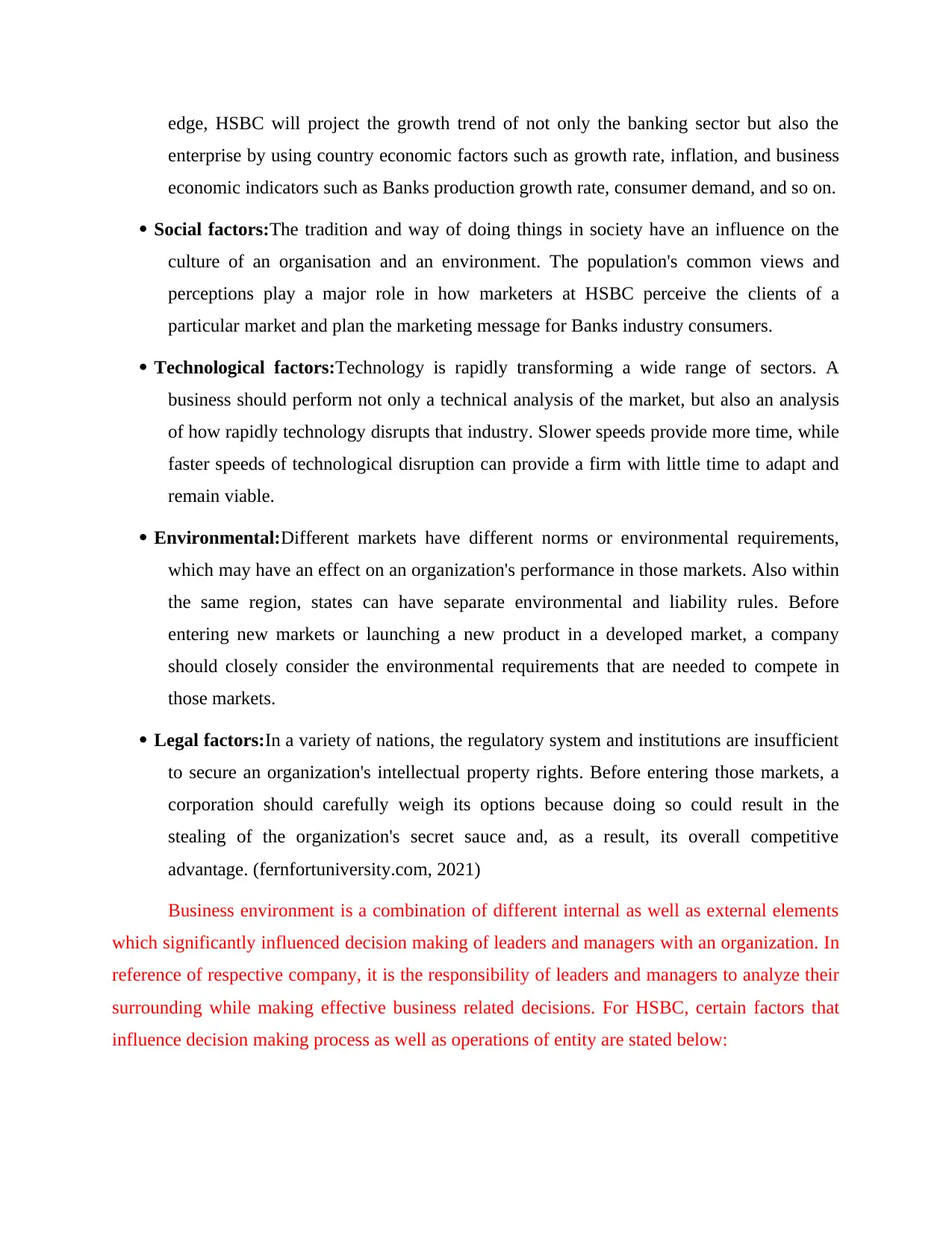
edge, HSBC will project the growth trend of not only the banking sector but also the
enterprise by using country economic factors such as growth rate, inflation, and business
economic indicators such as Banks production growth rate, consumer demand, and so on.
Social factors:The tradition and way of doing things in society have an influence on the
culture of an organisation and an environment. The population's common views and
perceptions play a major role in how marketers at HSBC perceive the clients of a
particular market and plan the marketing message for Banks industry consumers.
Technological factors:Technology is rapidly transforming a wide range of sectors. A
business should perform not only a technical analysis of the market, but also an analysis
of how rapidly technology disrupts that industry. Slower speeds provide more time, while
faster speeds of technological disruption can provide a firm with little time to adapt and
remain viable.
Environmental:Different markets have different norms or environmental requirements,
which may have an effect on an organization's performance in those markets. Also within
the same region, states can have separate environmental and liability rules. Before
entering new markets or launching a new product in a developed market, a company
should closely consider the environmental requirements that are needed to compete in
those markets.
Legal factors:In a variety of nations, the regulatory system and institutions are insufficient
to secure an organization's intellectual property rights. Before entering those markets, a
corporation should carefully weigh its options because doing so could result in the
stealing of the organization's secret sauce and, as a result, its overall competitive
advantage. (fernfortuniversity.com, 2021)
Business environment is a combination of different internal as well as external elements
which significantly influenced decision making of leaders and managers with an organization. In
reference of respective company, it is the responsibility of leaders and managers to analyze their
surrounding while making effective business related decisions. For HSBC, certain factors that
influence decision making process as well as operations of entity are stated below:
enterprise by using country economic factors such as growth rate, inflation, and business
economic indicators such as Banks production growth rate, consumer demand, and so on.
Social factors:The tradition and way of doing things in society have an influence on the
culture of an organisation and an environment. The population's common views and
perceptions play a major role in how marketers at HSBC perceive the clients of a
particular market and plan the marketing message for Banks industry consumers.
Technological factors:Technology is rapidly transforming a wide range of sectors. A
business should perform not only a technical analysis of the market, but also an analysis
of how rapidly technology disrupts that industry. Slower speeds provide more time, while
faster speeds of technological disruption can provide a firm with little time to adapt and
remain viable.
Environmental:Different markets have different norms or environmental requirements,
which may have an effect on an organization's performance in those markets. Also within
the same region, states can have separate environmental and liability rules. Before
entering new markets or launching a new product in a developed market, a company
should closely consider the environmental requirements that are needed to compete in
those markets.
Legal factors:In a variety of nations, the regulatory system and institutions are insufficient
to secure an organization's intellectual property rights. Before entering those markets, a
corporation should carefully weigh its options because doing so could result in the
stealing of the organization's secret sauce and, as a result, its overall competitive
advantage. (fernfortuniversity.com, 2021)
Business environment is a combination of different internal as well as external elements
which significantly influenced decision making of leaders and managers with an organization. In
reference of respective company, it is the responsibility of leaders and managers to analyze their
surrounding while making effective business related decisions. For HSBC, certain factors that
influence decision making process as well as operations of entity are stated below:
Paraphrase This Document
Need a fresh take? Get an instant paraphrase of this document with our AI Paraphraser
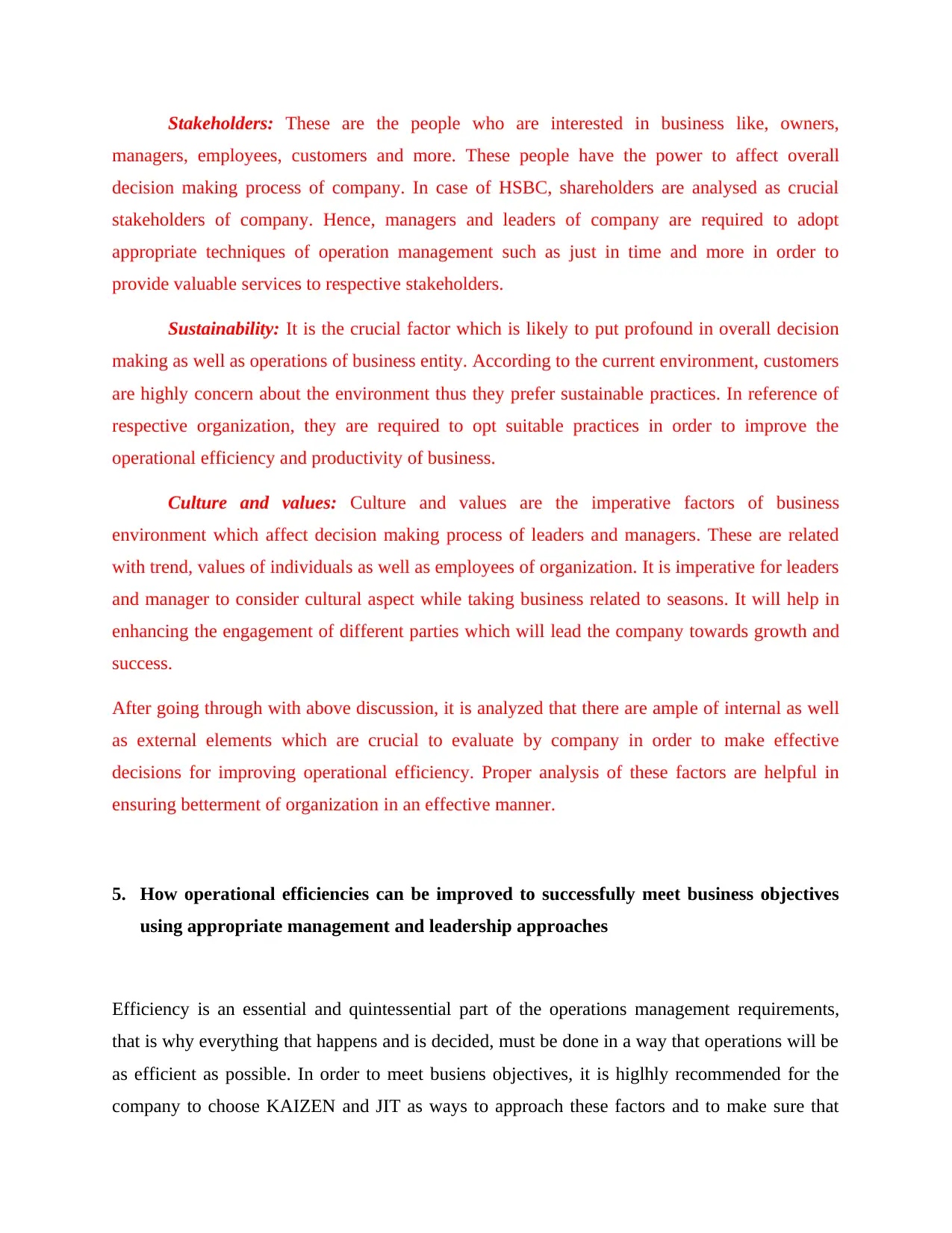
Stakeholders: These are the people who are interested in business like, owners,
managers, employees, customers and more. These people have the power to affect overall
decision making process of company. In case of HSBC, shareholders are analysed as crucial
stakeholders of company. Hence, managers and leaders of company are required to adopt
appropriate techniques of operation management such as just in time and more in order to
provide valuable services to respective stakeholders.
Sustainability: It is the crucial factor which is likely to put profound in overall decision
making as well as operations of business entity. According to the current environment, customers
are highly concern about the environment thus they prefer sustainable practices. In reference of
respective organization, they are required to opt suitable practices in order to improve the
operational efficiency and productivity of business.
Culture and values: Culture and values are the imperative factors of business
environment which affect decision making process of leaders and managers. These are related
with trend, values of individuals as well as employees of organization. It is imperative for leaders
and manager to consider cultural aspect while taking business related to seasons. It will help in
enhancing the engagement of different parties which will lead the company towards growth and
success.
After going through with above discussion, it is analyzed that there are ample of internal as well
as external elements which are crucial to evaluate by company in order to make effective
decisions for improving operational efficiency. Proper analysis of these factors are helpful in
ensuring betterment of organization in an effective manner.
5. How operational efficiencies can be improved to successfully meet business objectives
using appropriate management and leadership approaches
Efficiency is an essential and quintessential part of the operations management requirements,
that is why everything that happens and is decided, must be done in a way that operations will be
as efficient as possible. In order to meet busiens objectives, it is higlhly recommended for the
company to choose KAIZEN and JIT as ways to approach these factors and to make sure that
managers, employees, customers and more. These people have the power to affect overall
decision making process of company. In case of HSBC, shareholders are analysed as crucial
stakeholders of company. Hence, managers and leaders of company are required to adopt
appropriate techniques of operation management such as just in time and more in order to
provide valuable services to respective stakeholders.
Sustainability: It is the crucial factor which is likely to put profound in overall decision
making as well as operations of business entity. According to the current environment, customers
are highly concern about the environment thus they prefer sustainable practices. In reference of
respective organization, they are required to opt suitable practices in order to improve the
operational efficiency and productivity of business.
Culture and values: Culture and values are the imperative factors of business
environment which affect decision making process of leaders and managers. These are related
with trend, values of individuals as well as employees of organization. It is imperative for leaders
and manager to consider cultural aspect while taking business related to seasons. It will help in
enhancing the engagement of different parties which will lead the company towards growth and
success.
After going through with above discussion, it is analyzed that there are ample of internal as well
as external elements which are crucial to evaluate by company in order to make effective
decisions for improving operational efficiency. Proper analysis of these factors are helpful in
ensuring betterment of organization in an effective manner.
5. How operational efficiencies can be improved to successfully meet business objectives
using appropriate management and leadership approaches
Efficiency is an essential and quintessential part of the operations management requirements,
that is why everything that happens and is decided, must be done in a way that operations will be
as efficient as possible. In order to meet busiens objectives, it is higlhly recommended for the
company to choose KAIZEN and JIT as ways to approach these factors and to make sure that
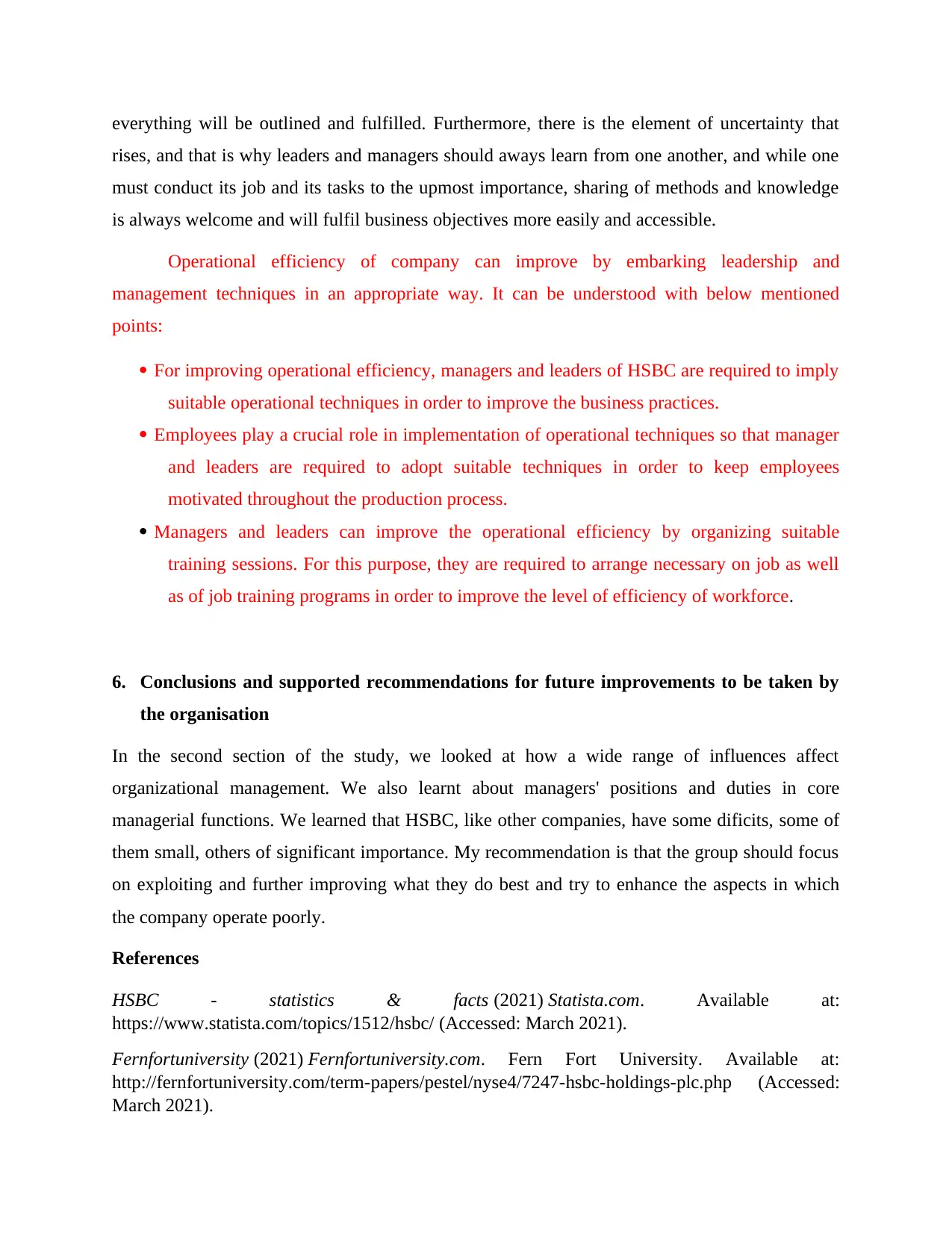
everything will be outlined and fulfilled. Furthermore, there is the element of uncertainty that
rises, and that is why leaders and managers should aways learn from one another, and while one
must conduct its job and its tasks to the upmost importance, sharing of methods and knowledge
is always welcome and will fulfil business objectives more easily and accessible.
Operational efficiency of company can improve by embarking leadership and
management techniques in an appropriate way. It can be understood with below mentioned
points:
For improving operational efficiency, managers and leaders of HSBC are required to imply
suitable operational techniques in order to improve the business practices.
Employees play a crucial role in implementation of operational techniques so that manager
and leaders are required to adopt suitable techniques in order to keep employees
motivated throughout the production process.
Managers and leaders can improve the operational efficiency by organizing suitable
training sessions. For this purpose, they are required to arrange necessary on job as well
as of job training programs in order to improve the level of efficiency of workforce.
6. Conclusions and supported recommendations for future improvements to be taken by
the organisation
In the second section of the study, we looked at how a wide range of influences affect
organizational management. We also learnt about managers' positions and duties in core
managerial functions. We learned that HSBC, like other companies, have some dificits, some of
them small, others of significant importance. My recommendation is that the group should focus
on exploiting and further improving what they do best and try to enhance the aspects in which
the company operate poorly.
References
HSBC - statistics & facts (2021) Statista.com. Available at:
https://www.statista.com/topics/1512/hsbc/ (Accessed: March 2021).
Fernfortuniversity (2021) Fernfortuniversity.com. Fern Fort University. Available at:
http://fernfortuniversity.com/term-papers/pestel/nyse4/7247-hsbc-holdings-plc.php (Accessed:
March 2021).
rises, and that is why leaders and managers should aways learn from one another, and while one
must conduct its job and its tasks to the upmost importance, sharing of methods and knowledge
is always welcome and will fulfil business objectives more easily and accessible.
Operational efficiency of company can improve by embarking leadership and
management techniques in an appropriate way. It can be understood with below mentioned
points:
For improving operational efficiency, managers and leaders of HSBC are required to imply
suitable operational techniques in order to improve the business practices.
Employees play a crucial role in implementation of operational techniques so that manager
and leaders are required to adopt suitable techniques in order to keep employees
motivated throughout the production process.
Managers and leaders can improve the operational efficiency by organizing suitable
training sessions. For this purpose, they are required to arrange necessary on job as well
as of job training programs in order to improve the level of efficiency of workforce.
6. Conclusions and supported recommendations for future improvements to be taken by
the organisation
In the second section of the study, we looked at how a wide range of influences affect
organizational management. We also learnt about managers' positions and duties in core
managerial functions. We learned that HSBC, like other companies, have some dificits, some of
them small, others of significant importance. My recommendation is that the group should focus
on exploiting and further improving what they do best and try to enhance the aspects in which
the company operate poorly.
References
HSBC - statistics & facts (2021) Statista.com. Available at:
https://www.statista.com/topics/1512/hsbc/ (Accessed: March 2021).
Fernfortuniversity (2021) Fernfortuniversity.com. Fern Fort University. Available at:
http://fernfortuniversity.com/term-papers/pestel/nyse4/7247-hsbc-holdings-plc.php (Accessed:
March 2021).
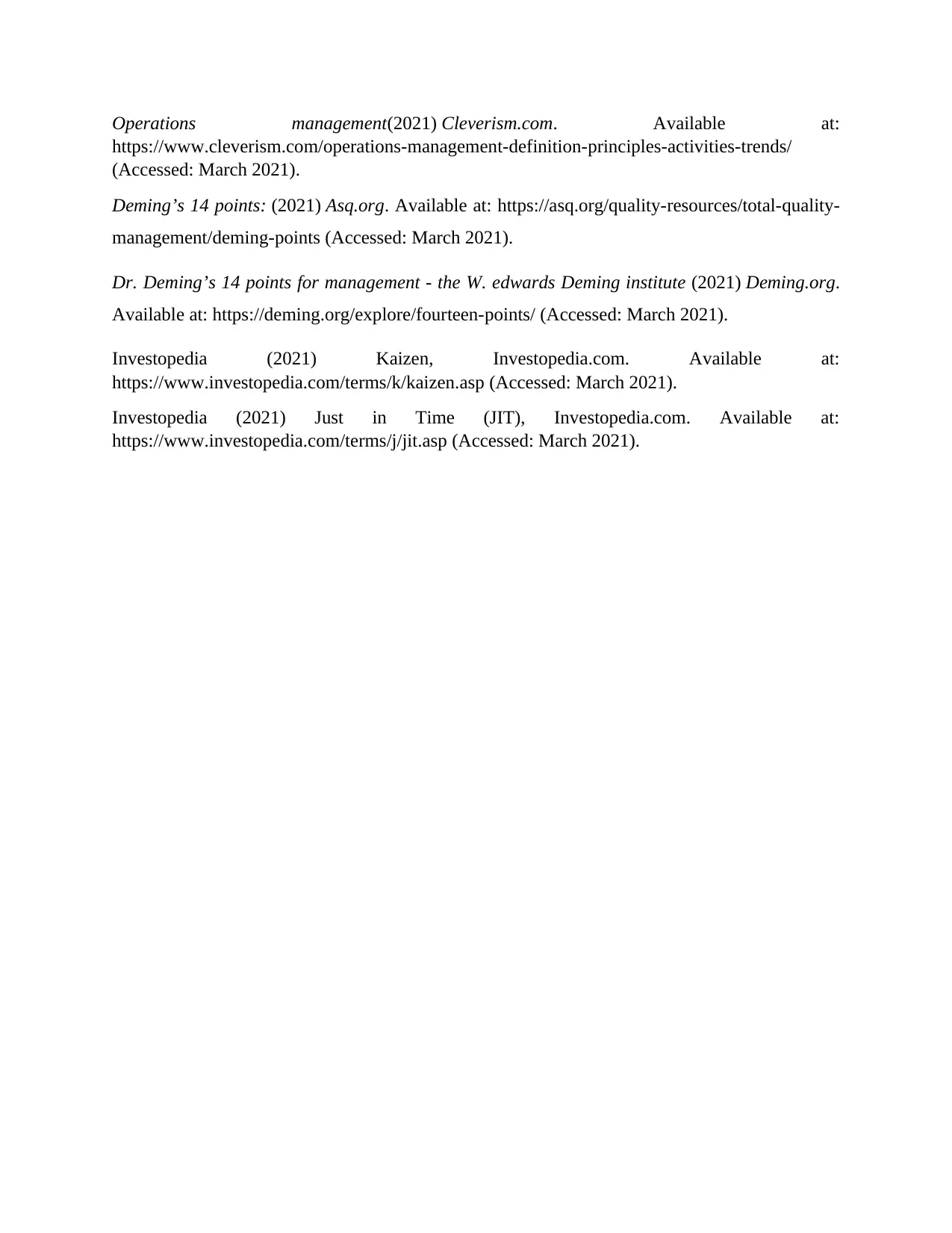
Operations management(2021) Cleverism.com. Available at:
https://www.cleverism.com/operations-management-definition-principles-activities-trends/
(Accessed: March 2021).
Deming’s 14 points: (2021) Asq.org. Available at: https://asq.org/quality-resources/total-quality-
management/deming-points (Accessed: March 2021).
Dr. Deming’s 14 points for management - the W. edwards Deming institute (2021) Deming.org.
Available at: https://deming.org/explore/fourteen-points/ (Accessed: March 2021).
Investopedia (2021) Kaizen, Investopedia.com. Available at:
https://www.investopedia.com/terms/k/kaizen.asp (Accessed: March 2021).
Investopedia (2021) Just in Time (JIT), Investopedia.com. Available at:
https://www.investopedia.com/terms/j/jit.asp (Accessed: March 2021).
https://www.cleverism.com/operations-management-definition-principles-activities-trends/
(Accessed: March 2021).
Deming’s 14 points: (2021) Asq.org. Available at: https://asq.org/quality-resources/total-quality-
management/deming-points (Accessed: March 2021).
Dr. Deming’s 14 points for management - the W. edwards Deming institute (2021) Deming.org.
Available at: https://deming.org/explore/fourteen-points/ (Accessed: March 2021).
Investopedia (2021) Kaizen, Investopedia.com. Available at:
https://www.investopedia.com/terms/k/kaizen.asp (Accessed: March 2021).
Investopedia (2021) Just in Time (JIT), Investopedia.com. Available at:
https://www.investopedia.com/terms/j/jit.asp (Accessed: March 2021).
1 out of 16
Related Documents
Your All-in-One AI-Powered Toolkit for Academic Success.
+13062052269
info@desklib.com
Available 24*7 on WhatsApp / Email
![[object Object]](/_next/static/media/star-bottom.7253800d.svg)
Unlock your academic potential
© 2024 | Zucol Services PVT LTD | All rights reserved.




